Complexity Theory
Mimivirus. Mimivirus is a viral genus containing a single identified species named Acanthamoeba polyphaga mimivirus (APMV).
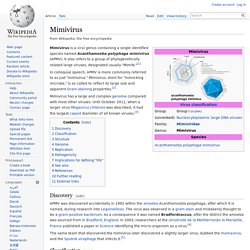
It also refers to a group of phylogenetically related large viruses, designated usually "MimiN.
"[1] In colloquial speech, APMV is more commonly referred to as just "mimivirus.
" Mimivirus, short for "mimicking microbe," is so called to reflect its large size and apparent Gram-staining properties.[2] Mimivirus has a large and complex genome compared with most other viruses. Discovery[edit] The same team that discovered the mimivirus later discovered a slightly larger virus, dubbed the mamavirus, and the Sputnik virophage that infects it.[5]
Lynn Margulis and Dorion Sagan - Microbial Microcosm. Just how interconnected are we?

Richard Dawkins. Steffen Wischmann - Research. Social behavior can be found on almost every level of life, ranging from microorganisms to human societies.

However, explaining the evolutionary emergence of cooperation, communication, or competition still challenges modern biology. The most common approaches to this problem are based on game-theoretic models. The problem is that these models often assume fixed and limited rules and actions that individual agents can choose from, which excludes the dynamical nature of the mechanisms that underlie the behavior of living systems.
Networks, Crowds, and Markets: A Book by David Easley and Jon Kleinberg. In recent years there has been a growing public fascination with the complex "connectedness" of modern society.

This connectedness is found in many incarnations: in the rapid growth of the Internet and the Web, in the ease with which global communication now takes place, and in the ability of news and information as well as epidemics and financial crises to spread around the world with surprising speed and intensity. These are phenomena that involve networks, incentives, and the aggregate behavior of groups of people; they are based on the links that connect us and the ways in which each of our decisions can have subtle consequences for the outcomes of everyone else. Networks, Crowds, and Markets combines different scientific perspectives in its approach to understanding networks and behavior. The book is based on an inter-disciplinary course that we teach at Cornell. The book, like the course, is designed at the introductory undergraduate level with no formal prerequisites.
Sito bibliografico sull’opera di Edgar Morin. Edgar Morin è uno dei maggiori filosofi contemporanei.

The Secret Life of Chaos (Part 2/6)
Idee und Klang - BMW Museum - BWM INSPIRATION - Kinetic Sculpture. BMW Museum - Kinetic Sculpture. Manuelbaez [licensed for non-commercial use only] / TEDx presentation. TEDxCarletonU 2010 - Manuel A. Báez - Crystal & Flame: Form and Process. Butterfly - The Secret Life of Chaos - BBC 4 Preview. Self Organization. Crazy Vietnam crossroad. Self-organization in hanoi traffic. Zachman Framework. The Zachman Framework of enterprise architecture The Zachman Framework is not a methodology in that it does not imply any specific method or process for collecting, managing, or using the information that it describes.;[2] rather, it is an Ontology whereby a schema for organizing architectural artifacts (in other words, design documents, specifications, and models) is used to take into account both whom the artifact targets (for example, business owner and builder) and what particular issue (for example, data and functionality) is being addressed.[3] The framework is named after its creator John Zachman, who first developed the concept in the 1980s at IBM.
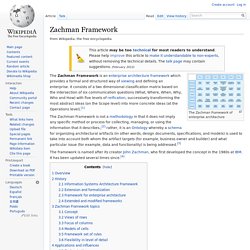
It has been updated several times since.[4] Overview[edit] The term "Zachman Framework" has multiple meanings. Collage of Zachman Frameworks as presented in several books on Enterprise Architecture from 1997 to 2005.
ISSS paper - 1999. This paper brought together a number of subjects, in an early, almost extended outline.
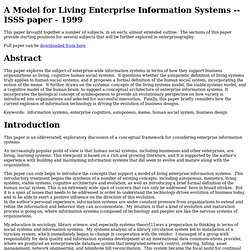
The sections of this paper provide starting positions for several subjects that will be further explored in enterprisography. Full paper can be downloaded from here. This paper explores the subject of enterprise-wide information systems in terms of how they support business organizations as living, cognitive human social systems. It questions whether the autopoietic definition of living systems truly applies to human social systems, and it proposes a formal definition of the human social system, incorporating the notion of the meme. It further draws on the systemic concepts of the living systems model, the viable systems model, and a cognitive model of the human brain, to suggest a conceptual architecture of enterprise information systems.
About the Artist. Origami – paper as prototype « pencils polymer & pixels. Numeri in natura Cristòbal Vila. [마음―몸―시공간 Mind―Body―Spacetime] "책과 통하는 블로그, 알라딘 서재!"
창발Emergence 관련 논문과 저작들 ― 마음/의식과 관련하여.
![[마음―몸―시공간 Mind―Body―Spacetime] "책과 통하는 블로그, 알라딘 서재!"](http://cdn.pearltrees.com/s/pic/th/mind-body-spacetime-12357061)
European Management Journal : Complexity, simplicity, simplexity. COPING WITH COMPLEXITY. Complex systems tutorial. Jan Burian burianj (at) vse.cz You can find here: Basic introduction to Complex Systems Science and relevant modeling tools Many links to web resources and a list of relevant literature "Complex systems" (4IZ636), lecture on University of Economics, Prague Content.
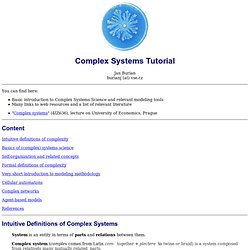
Rachel Gottlieb’s Simplicity to Complexity-Form Studies. Simplicity & Complexity. Agile Management - Complexity Thinking. How the size of networks can skyrocket
The growth process of networks.
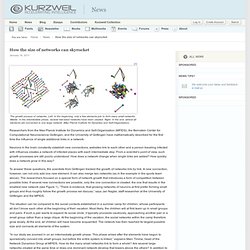
Left: In the beginning, only a few elements join to form many small networks. Middle: In the intermediate phase, several mid-sized networks have been created. Right: In the end, almost all elements are connected in one large network.
Strategie evolutive - scopo. Strategie evolutive. Caos. La vita si evolve verso un regime di equilibrio tra l’ordine e il caos. Suggestiva l’immagine che la vita esiste ai confini del caos. Quasi come se la vita esistesse in una sorta di transizione, nello stato ordinato adiacente alla transizione di fase che porta al caos.
Rate a business. An Outline for an Integral Meta-Studies, Mark Edwards. Mark Edwards is an Assitant Professor at the University of Western Australia Business School and adjunct lecturer at John F.
Kennedy University in California. He teaches in the areas of business ethics, organizational change and transformation and integrative metatheory. He has published in scholarly journals on a variety of topics including organizational development, organizational learning, sustainability, futures studies, cultural evolution, disability studies, metatheory development and integrative metastudies. Mark's PhD thesis was awarded with distinction and is published by Routledge under the title "Organizational Transformation for Sustainability: An Integral Metatheory".
FOLP Project - Keynote address. Social Futures in an On-line World Barbara Lepani Lateral Solutions (Aust) Pty Ltd and The Australian Centre for Innovation, The University of Sydney We can look at the emerging future of our society through the lens of three possible scenarios: A comfortable Australia with a large secure middle class based on well paid employment in secure jobs, home ownership and high levels of education, with just a small percentage of the population able to accumulate above average wealth due to circumstances of birth or talent, and just a small percentage of the population living below the poverty line due to their inability to participate in the workforce or failure to accumulate savings to augment the pension in old age.
As Mackay has noted, this post materialist generation talks a great deal about "spirituality".
Complex Systems Management, Business Risk Management. The complexity of communicating…complexity « Get "fit for randomness" [with Ontonix UK]
Monday, 29 November, 2010 Complexity is, to many, a pretty abstract concept and that, as some would say, makes it a pretty “tough sell”. Fair point. It would take a pretty long elevator ride to get the pitch across to someone who has no idea what you are talking about…or why. Having said that I haven’t tested it out on unsuspecting elevator passengers. Mainly because we really don’t have too many buildings tall enough to practice in!!!
Comparison of the bionic, fractal and holonic manufacturing system concepts - International Journal of Computer Integrated Manufacturing. Over the next decade production will experience an enormous increase in variety and great reduction in batch sizes.
Customers will have more individualistic desires and will participate in the design and production, and will be involved in details of services via electronic means. To meet these demands current organizations will be replaced by more innovative organic structures.
ADRENALIN - Advanced Fractal Companies use Information Supply Chains. Managing information supply chains. Europe's position in the ever more competitive marketplace depends upon the improved performance of European enterprises. The ADRENALIN project, funded by the European Commission's Information Society Technologies (IST) Programme for Research and Development, approaches this task in a novel way by tackling two key areas where the most significant improvements may be obtained, namely, optimisation of information management and changing the current function-oriented approach to process orientation.
Management of information flow in the enterprise uses the Information Supply Chain concept, while our drive towards process orientation is tackled using the Fractal Company approach. These two "pillar" concepts of the project are briefly described further below. Key Concepts Conventional supply chains concern all material-management stages from the supply of raw material through to the sale of final product to the end customer.
Versita Publications - Journal Article.
The Fractal Company: A Revolution in Corporate Culture (9783540565376): Hans-Jürgen Warnecke, M. Claypole, M. Hüser. Fractals. Giappone, l'accusa del sismologo "Mappe sbagliate o obsolete. Il professor Robert J.
Competere nella complessità. Search Results - complexity theory. Complexity Theory. The Communication Circle: Articles on Complex Documentation: Complexity Theory. Speech to IPCC 97, October, 1997; final version available in Proceedings, IEEE Professional Communication Society, 17-27.
Jonathan Price Complexity theory offers concepts that can help technical communicators understand the exponential growth in the volume of inter-related and interacting information objects as the result of the law of increasing returns, which has brought us through a phase transition to a new environment, with emergent properties, demanding new behaviors.
Laws of Technological Progress with J. Doyne Farmer. A Sociological Approach to Complex Systems. Integrating complexity theory, knowledge management and organizational learning.
Fulltext Options: Login Existing customers: loginto access this document Purchase Downloadable; Printable; OwnedHTML, PDF (447kb) To purchase this item please login or register. Rent Recommend to your librarian. Conspansive Manifold, Complexity Generation, Generative Automata, Ontological Knowledge, Infomorphic Semantics, Polymorphic Isotelesis, Holomorphic Autotelesis, Isomorphic Polytelesis, Automorphic Holotelesis, Distributed Koinontelesis, Value Utility - un.
² bodycard 0643








![[마음―몸―시공간 Mind―Body―Spacetime] "책과 통하는 블로그, 알라딘 서재!"](http://cdn.pearltrees.com/s/pic/th/mind-body-spacetime-12357061)

